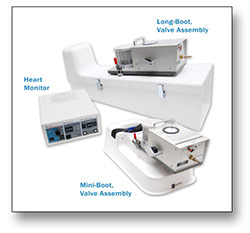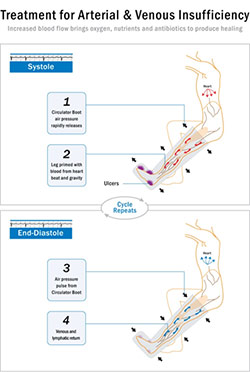|
 |
- Product Overview
- Operational Instructions
- Downloads
- Technical Specifications
The name Circulator Boot™ was chosen to indicate a device that benefited heart function and all of the circulations in the body: arterial, venous and lymphatic. It is noninvasive and its use is contraindicated only by the presence of fresh deep vein thrombi in the legs and/or aortic valvular insufficiency associated with heart failure.
The Circulator Boot™ is more than a product. Its use in limb salvage has evolved into a Method of Treatment that supports the core elements of wound therapy: increased blood supply, bacterial control, moisture and debridement. Combined with the use of local antibiotic injections, for example, boot therapy may improve the blood supply and control the infection in patients with osteomyelitis and necrotizing cellulitis when standard methods of treatment are failing. |
 |
The end-diastolic timing of its leg compressions is unique and has been used in large numbers of patients to salvage legs at risk of amputation. It also has other promising uses that deserve study and serious consideration: treatment of patients with angina, congestive heart failure, stroke, kidney failure and septic shock. |
|
A leg with poor arterial blood flow may be likened to a dirty sponge that is half wet. Squeezing such a sponge disseminates the water throughout the sponge. Soaking and wringing the water repeatedly from the sponge may help clean it. In like fashion, the heart monitor of the Circulator Boot™ is timed to allow each arterial pulse wave to enter the leg as best it can (to partially wet the leg "sponge"). Boot compressions provide a driving force to disseminate blood around the leg and at the same time press venous blood and excess tissue water from the leg. Patients with a pulse rate of 80 beats per minute might receive 4800 such compressions an hour. Patients with severe arterial leg disease might receive 100 such treatments or close to a half million compressions! Breakdown of clot, rechannelization of blocked vessels and the formation of new small vessels may help restore blood flow. |
The Circulator Boot™ is an FDA approved non-invasive technology Patients have been successfully treated with the Circulator Boot™ at the Mayo Clinic, Bryn Mawr Wound & Vascular Center, Temple School of Podiatric Medicine, Jacksonville Foot & Ankle Center, St. Luke's South Shore and many physician based treatment centers. This FDA approved non-invasive technology is a major breakthrough for patients facing the grim prospect of a leg amputation from the complications of diabetes. Poor circulation and infection are the leading causes of 90,000 diabetic amputations that occur every year in the United States. Patients with critical limb ischemia, osteomyelitis and or congestive heart failure have few treatment alternatives. |
| KEY PRODUCT FEATURES |
- A controller unit to detect the QRS complex of the cardiac rhythm and to appropriately time boot compressions at the end portion of the heart cycle.
- A rapid action valve assembly capable of both pressurizing and exhausting the boot within a fraction of a second.
- Rigid, adjustable long boot to enclose the leg from groin to toes.
- Disposable double-walled plastic bags to enclose the chosen portion of the leg and to contain the compressed air.
- Rigid Miniboot to enclose the foot and ankle for patients requiring treatment of the foot only.
- Fluted lower leg legging to extend the Miniboot treatment to the thigh.
- Compressed air supply to power the circulator boot compression cycles.
|
| APPLICATION AND TREATMENT |
| 1. |
Check bag for air leaks. Trap air and hold up to light to detect escaping air. Air leaks prevent full pressure during treatment. |
| 2. |
CAREFULLY place leg in bag. |
| 3. |
Insert bagged leg in the bottom portion of boot; move partitions snuggly against leg, fold and buckle plastic aprons over leg. towels may be wrapped around leg above ankle to elevate heel and around upper thigh to protect thigh from edge of boot. Be sure the bag fits loosely around the toes to avoid discomfort and leave some slack in the bag around the Styrofoam ring. The plastic tonge is held in place by folding aprons. A foam rubber pad may be placed beneath the heel. Place top of boot in place and fasten clamp at sides of boot. |
| 4. |
Connect bag Styrofoam ring to valve inlet pipe by reaching down inside the pipe and carefully sliding the ring up around the pipe. Be sure the ring is seated all the way against the top of the boot. |
| 5. |
Fasten posey belt across the bottom of the boot. Tie each end to vertical slats on bed rails to prevent sliding. |
| 6. |
Place valve assembly on top of boot and fasten with the quarter-turn screws. |
| 7. |
Unscrew pressure know on top of valve assembly. Prevents starting treatment at high pressure, reducing possibility of injury. |
| 8. |
Attach monitor cable to valve assembly. |
| 9. |
Apply electrodes to chest, black-lower edge of sternum; white-below and lateral to left nipple; green - anywhere on chest. Monitor is designed to pump during diastole, therefore cardiac leads are needed. |
| 10. |
Set monitor pressure according to physician's order |
| 11. |
Plug monitor into electrical outlet. |
| 12. |
Plug air line into compressed air socket. |
| 13. |
Turn monitor to "ON". |
| 14. |
Re-adjust pressure knob to settings as ordered by physician. |
|
| |
| |
| REMOVING THE BOOT |
| 1. |
Turn monitor to "OFF" position. |
| 2. |
Disconnect electric plug. |
| 3. |
Disconnect air line from wall socket. |
| 4. |
Remove monitor cables from patient's chest. |
| 5. |
Remove Valve assembly from top of boot:
a. Turn bolt wing screws at top of assembly one quarter turn to loosen the valve assembly. If screw is turned too far, it will disconnect from assembly.
b. Lift valve assembly from boot. Place on flat surface.
NOTE: If any objects press on foam ring at bottom of valve assembly, it can be permanently damaged, resulting in loss of pressure when the boot is applied. |
| 6. |
Unfasten clamps at sides of boot. Remove top section of boot (LID). |
| 7. |
Unhook straps. Remove any towels which have been used to fill in space. |
| 8. |
Holding plastic aprons apart, carefully lift the patient's leg out of boot (LID). Place bottom section of boot on flat surface. |
| 9. |
Remove plastic bag and fold bag carefully. Any tears in plastic bag will prevent lack of pressure in reapplication. |
|
|
|
| Click here to download Adobe Acrobat Reader. |
| POWERPOINT Slide Presentation on Peripheral Vascular Disease and the Physiology of Booting |
Our speakers have used these and other slides in their lectures on the Pathophysiology of the Diabetic Foot and its treatment with the Circulator Boot™. Our website visitors are welcome to use this material in their own presentations.
They will find two Power Point presentations, one providing general background (Circulator Boot General Information) in the field and the other providing slides on our Method of Treatment (Method of Treatment). Use the "back" button to return from Power Point. Click on the slide to advance to the next slide. These slides project well on a large screen with a Power Point presentation. Some are too detailed to show well on a computer screen. Visitors or physicians who have slide material that they feel should be included in this presentation are to be encouraged to provide us with their material. If it is adequately documented, we will add the references to our library and the slide material to this presentation. |
 |
Power Point: Circulator Boot General Information (14 mgs) |

|
Power Point: Method of Treatment (1.5 mgs) |
| |
| Links to Organizations, Doctors and Other Professionals |
We include here links to various entities interested in circulatory problems of the lower limbs. To find clinics and physicians experienced in boot therapies, see the links in our section on Boot Clinics. For literature on pneumatic boots, see the "Pneumatic Boot" section in our library.
|
| Circulator Boot™ System |
| Heart Monitor |
Directs timing of the compression |
| Valve Assembly |
Gateway for air –
compression & release |
| Mini-Boot |
Treats the calf and foot |
| Long-Boot |
Treats the entire leg |
| Compressed Air Source |
Drives the Valve Assembly |
Reusable Compression
Bags and Compression
Wraps |
Contains compressed air |
|
 |
- The Circulator Boot™ is timed to allow each
pulse wave to enter the leg at systole
- Compressions provide a driving force to
disseminate blood around the leg
- Patients with a pulse rate of 60 beats/minute
receive 1200 compressions per treatment
- The movement of oxygenated blood through
the leg and foot promotes healing
- Treatments break down arterial thrombi and help
form new small vessels
|
 |
|
|